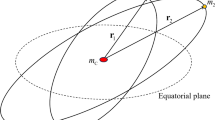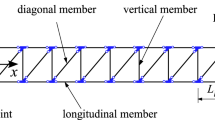Abstract
Although the complex structure-preserving method presented in our previous studies can be used to investigate the orbit–attitude–vibration coupled dynamic behaviors of the spatial flexible damping beam, the simulation speed still needs to be improved. In this paper, the infinite-dimensional dynamic model describing the orbit–attitude–vibration coupled dynamic problem of the spatial flexible damping beam is pretreated by the method of separation of variables, and the second-level fourth-order symplectic Runge–Kutta scheme is constructed to investigate the coupling dynamic behaviors of the spatial flexible damping beam quickly. Compared with the simulation speed of the complex structure-preserving method, the simulation speed of the symplectic Runge–Kutta method is faster, which benefits from the pretreatment step. The effect of the initial radial velocity on the transverse vibration as well as on the attitude evolution of the spatial flexible damping beam is presented in the numerical examples. From the numerical results about the effect of the initial radial velocity, it can be found that the appearance of the initial radial velocity can decrease the vibration frequency of the spatial beam and shorten the evolution interval for the attitude angle to tend towards a stable value significantly. In addition, the validity of the numerical results reported in this paper is verified by comparing with some numerical results presented in our previous studies.




Similar content being viewed by others
References
Hu W, Zhang C, Deng Z. Vibration and elastic wave propagation in spatial flexible damping panel attached to four special springs. Commun Nonlinear Sci Numer Simul. 2020;84:105199.
Hu W, Ye J, Deng Z. Internal resonance of a flexible beam in a spatial tethered system. J Sound Vib. 2020;475:115286.
Hu W, Song M, Deng Z. Energy dissipation/transfer and stable attitude of spatial on-orbit tethered system. J Sound Vib. 2018;412:58–73.
Hu W, Li Q, Jiang X, Deng Z. Coupling dynamic behaviors of spatial flexible beam with weak damping. Int J Numer Methods Eng. 2017;111:660–75.
Hu W, Deng Z. Non-sphere perturbation on dynamic behaviors of spatial flexible damping beam. Acta Astronaut. 2018;152:196–200.
Fu B, Sperber E, Eke F. Solar sail technology-A state of the art review. Prog Aerosp Sci. 2016;86:1–19.
Cartmell MP, McKenzie DJ. A review of space tether research. Prog Aerosp Sci. 2008;44:1–21.
Shabana AA. Definition of the slopes and the finite element absolute nodal coordinate formulation. Multibody Syst Dyn. 1997;1:339–48.
Shabana AA. Dynamics of multibody systems. New York: Wiley; 1989.
Shabana AA, Schwertassek R. Equivalence of the floating frame of reference approach and finite element formulations. Int J Non-Linear Mech. 1998;33:417–32.
De Veubeke BF. The dynamics of flexible bodies. Int J Eng Sci. 1976;14:895–913.
Shabana AA, Hussien HA, Escalona JL. Application of the absolute nodal coordinate formulation to large rotation and large deformation problems. J Mech Des. 1998;120:188–95.
Omar MA, Shabana AA. A two-dimensional shear deformable beam for large rotation and deformation problems. J Sound Vib. 2001;243:565–76.
Shen Z, Li P, Liu C, Hu G. A finite element beam model including cross-section distortion in the absolute nodal coordinate formulation. Nonlinear Dyn. 2014;77:1019–33.
Hu W, Tian Q, Hu H. Dynamic simulation of liquid-filled flexible multibody systems via absolute nodal coordinate formulation and SPH method. Nonlinear Dyn. 2014;75:653–71.
Orzechowski G, Shabana AA. Analysis of warping deformation modes using higher order ANCF beam element. J Sound Vib. 2016;363:428–45.
Li Q, Deng Z, Zhang K, Huang H. Unified modeling method for large space structures using absolute nodal coordinate. AIAA J. 2018;56:4146–57.
Luo CQ, Sun JL, Wen H, Jin DP. Dynamics of a tethered satellite formation for space exploration modeled via ANCF. Acta Astronaut. 2020;177:882–90.
Cavin R III, Dusto A. Hamilton’s principle-finite-element methods and flexible body dynamics. AIAA J. 1977;15:1684–90.
Gerstmayr J. Strain tensors in the absolute nodal coordinate and the floating frame of reference formulation. Nonlinear Dyn. 2003;34:133–45.
Berzeri M, Campanelli M, Shabana AA. Definition of the elastic forces in the finite-element absolute nodal coordinate formulation and the floating frame of reference formulation. Multibody Syst Dyn. 2001;5:21–54.
Dibold M, Gerstmayr J, Irschik H. A detailed comparison of the absolute nodal coordinate and the floating frame of reference formulation in deformable multibody systems. J Comput Nonlinear Dyn. 2009;4:021006.
Hartweg S, Heckmann A. Moving loads on flexible structures presented in the floating frame of reference formulation. Multibody Syst Dyn. 2016;37:195–210.
Lozovskiy A, Dubois F. The method of a floating frame of reference for non-smooth contact dynamics. Eur J Mech a-Solids. 2016;58:89–101.
Cammarata A, Pappalardo CM. On the use of component mode synthesis methods for the model reduction of flexible multibody systems within the floating frame of reference formulation. Mech Syst Signal Process. 2020;142:106745.
Cammarata A. Global flexible modes for the model reduction of planar mechanisms using the finite-element floating frame of reference formulation. J Sound Vib. 2020;489:115668.
Hu W, Xu M, Song J, Gao Q, Deng Z. Coupling dynamic behaviors of flexible stretching hub-beam system. Mech Syst Signal Process. 2021;151:107389.
Hu W, Xu M, Jiang R, Zhang C, Deng Z. Wave propagation in non-homogeneous asymmetric circular plate. Int J Mech Mater Des. 2021. https://doi.org/10.1007/s42417-021-00355-1.
Hu W, Huai Y, Xu M, Feng X, Jiang R, Zheng Y, Deng Z. Mechanoelectrical flexible hub-beam model of ionic-type solvent-free nanofluids. Mech Syst Signal Process. 2021;159:107833.
Hu W, Yu L, Deng Z. Minimum control energy of spatial beam with assumed attitude adjustment target. Acta Mech Solida Sin. 2020;33:51–60.
Hu W, Wang Z, Zhao Y, Deng Z. Symmetry breaking of infinite-dimensional dynamic system. Appl Math Lett. 2020;103:106207.
Hu WP, Deng ZC, Han SM, Zhang WR. Generalized multi-symplectic integrators for a class of Hamiltonian nonlinear wave PDEs. J Comput Phys. 2013;235:394–406.
Sanz-Serna JM. Symplectic Runge–Kutta schemes for adjoint equations, automatic differentiation, optimal control, and more. SIAM Rev. 2016;58:3–33.
Sanz-Serna JM. Runge–Kutta schemes for Hamiltonian systems. BIT Numer Math. 1988;28:877–83.
Feng K. On difference schemes and symplectic geometry. In: Proceeding of the 1984 Beijing symposium on differential geometry and differential equations, Science Press, Beijing, 1984;42–58.
Lim CW, Xu XS. Symplectic elasticity: theory and applications. Appl Mech Rev. 2010;63:050802.
Lim CW, Lue CF, Xiang Y, Yao W. On new symplectic elasticity approach for exact free vibration solutions of rectangular Kirchhoff plates. Int J Eng Sci. 2009;47:131–40.
Lim CW, Cui S, Yao WA. On new symplectic elasticity approach for exact bending solutions of rectangular thin plates with two opposite sides simply supported. Int J Solids Struct. 2007;44:5396–411.
Wang DL, Xiao AG, Li XY. Parametric symplectic partitioned Runge–Kutta methods with energy-preserving properties for Hamiltonian systems. Comput Phys Commun. 2013;184:303–10.
Jay L. Symplectic partitioned Runge–Kutta methods for constrained Hamiltonian systems. SIAM J Numer Anal. 1996;33:368–87.
Calvo MP, Sanzserna JM. High-order symplectic Runge–Kutta–Nyström methods. SIAM J Sci Comput. 1993;14:1237–52.
Hu W, Yin T, Zheng W, Deng Z. Symplectic analysis on orbit-attitude coupling dynamic problem of spatial rigid rod. J Vib Control. 2020;26:1614–24.
Hu W, Huai Y, Xu M, Deng Z. Coupling dynamic characteristics of simplified model for tethered satellite system. Acta Mechanica Sinica. 2021. https://doi.org/10.1007/s10409-021-01108-9.
Kirstein PT, Kino GS. Solution to the equations of space-charge flow by the method of separation of variables. J Appl Phys. 1958;29:1758–67.
Martin MH. A generalization of the method of separation of variables. J Rational Mech Anal. 1953;2:315–27.
Wu C, Rui W. Method of separation variables combined with homogenous balanced principle for searching exact solutions of nonlinear time-fractional biological population model. Commun Nonlinear Sci Numer Simul. 2018;63:88–100.
Sanzserna JM. Symplectic Runge–Kutta and related methods—recent results. Physica D-Nonlinear Phenomena. 1992;60:293–302.
Saito S, Sugiura H, Mitsui T. Family of symplectic implicit Runge–Kutta formulas. BIT. 1992;32:539–43.
Zhou W, Zhang J, Hong J, Song S. Stochastic symplectic Runge–Kutta methods for the strong approximation of Hamiltonian systems with additive noise. J Comput Appl Math. 2017;325:134–48.
Reich S. Multi-symplectic Runge–Kutta collocation methods for Hamiltonian wave equations. J Comput Phys. 2000;157:473–99.
Acknowledgements
The research was supported by the National Natural Science Foundation of China (12172281, 11972284 and 11872303), Fund for Distinguished Young Scholars of Shaanxi Province (2019JC-29), Foundation Strengthening Programme Technical Area Fund (2021-JCJQ-JJ-0565), Fund of the Youth Innovation Team of Shaanxi Universities and the Open Foundation of State Key Laboratory of Structural Analysis of Industrial Equipment (GZ19103).
Author information
Authors and Affiliations
Corresponding author
Rights and permissions
About this article
Cite this article
Hu, W., Xi, X., Zhai, Z. et al. Symplectic Analysis on Coupling Behaviors of Spatial Flexible Damping Beam. Acta Mech. Solida Sin. 35, 541–551 (2022). https://doi.org/10.1007/s10338-021-00297-x
Received:
Revised:
Accepted:
Published:
Issue Date:
DOI: https://doi.org/10.1007/s10338-021-00297-x




